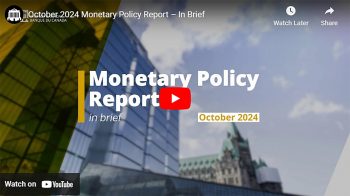
Monetary policy
In 2024, the Bank of Canada was successful in bringing inflation back to the 2% target. With inflationary pressures easing and with excess capacity in the economy, the Bank started lowering its policy interest rate in June. Thereafter, it reduced the rate four more times, bringing it to 3.25% by the end of the year. The Bank also continued to normalize its balance sheet with quantitative tightening.
Inflation in the consumer price index (CPI) fell from 2.9% in January to 1.8% in December. At the end of 2024, inflation was no longer broad-based. Inflation expectations and corporate pricing behaviour had returned to normal. While still elevated, inflation in shelter prices started easing.
Growth in real gross domestic product (GDP) in Canada was modest in 2024, reflecting the lingering effects of past monetary policy tightening. The labour market softened, and although wage growth was elevated, it began to ease.
Monitoring the Canadian economy
The Bank used timely and comprehensive information about the evolution of the Canadian and global economies to inform monetary policy. The Bank’s ongoing monitoring of inflation dynamics, inflation expectations and GDP growth enabled it to determine the appropriate timing and pace of cuts to its policy interest rate.
Tracking inflation dynamics and expectations
In the first half of 2024, CPI inflation eased below 3%. Lower inflation for goods was a major contributor to the decline. However, inflation remained elevated and inflationary pressures were still somewhat broad-based. Shelter inflation was also still high.
By October, inflationary pressures were no longer broad-based. The share of CPI components growing above 3% had normalized. Inflation expectations declined as inflation eased. Firms and households surveyed in late 2024 expected inflation to be in the range of 2% to 3%.
| Key indicators | Reference level | 2017 | 2018 | 2019 | 2020 | 2021 | 2022 | 2023 | 2024 |
|---|---|---|---|---|---|---|---|---|---|
| CPI inflation (%) | 2.0 | 1.6 | 2.3 | 1.9 | 0.7 | 3.4 | 6.8 | 3.9 | 2.4 |
| Average CPI inflation since 2001 (%) | 2.2 | ||||||||
| Inflation expectations at a 10-year horizon (%) | 2.0 | 2.0 | 2.0 | 2.0 | 2.0 | 2.0 | 2.0 | 2.0 | 2.1 |
Assessing that the Canadian economy was in excess supply
After stalling in mid-2023, Canada’s GDP growth strengthened in 2024, though improvements varied across sectors.
Consumption and government spending were the main contributors to GDP growth. At the same time, sectors sensitive to interest rates—such as housing and business investment—were weak. And while population increases supported spending, consumption per person remained soft in 2024.
The effects of past monetary policy tightening continued to restrain economic activity. The labour market eased further, and slack emerged—mostly among youth and newcomers to Canada. Overall, the economy was in excess supply in 2024.
Spending on housing and big-ticket items started to improve in the latter half of 2024, reflecting early impacts of the 2024 policy rate reductions.
Normalizing the Bank’s balance sheet
Quantitative tightening continued to shrink the size of the Bank’s balance sheet—bringing it from $316.8 billion at the end of 2023 to $277.2 billion at the end of 2024.
The Bank continued to prepare for when its balance sheet returns to normal levels in 2025. In March, it communicated when it believed quantitative tightening would end and what assets it would purchase to manage its balance sheet thereafter. 1

External Deputy Governor Nicolas Vincent gives a behind-the-scenes look to the Sherbrooke Chamber of Commerce and Industry in September about the Bank’s monetary policy decision-making process.
Implementing monetary policy
More frequent overnight repo operations were necessary in 2024, in large part because of structural changes in the overnight funding market. The May 2024 transition from two days to one day for settling securities transactions in Canada, combined with increased hedge fund activity in the repo market, put upward pressure on CORRA, the measure of the cost of overnight general funding in Canadian dollars.2 To address these pressures, the Bank made adjustments to its framework for overnight repo operations, which promoted trading at rates closer to the Bank’s target.
Supporting the Bank’s monetary policy function
Amid complex forces affecting supply, demand and inflationary pressures, the Bank’s 2024 forecasts correctly anticipated that inflation would continue progressing toward the 2% target and that there would be a return to modest growth in Canada in 2024.
The Bank continued to refine its macroeconomic models. This includes enhancing its modelling of the supply side of the economy and developing alternative models of inflation.
Analyzing inflation dynamics and the transmission of monetary policy
Staff conducted research and analysis to improve the Bank’s understanding of how inflation dynamics were evolving. This included exploring the effect of corporate price-setting behaviour on inflation, and differences in the inflation experiences of low- and high-income households.3 Bank staff also continued to assess the transmission of monetary policy to the economy.4
The Bank also used its surveys to deepen its understanding of both inflation dynamics and the transmission of monetary policy.5 Data collected from consumers, businesses and market participants offered insights into their experiences. Additionally, conferences hosted by the Bank brought together policymakers and academics to discuss a range of issues related to monetary policy.
Exploring the impact of structural changes in the Canadian economy
The Bank continued to investigate the effects that structural changes, such as demographic shifts and the transition to net-zero emissions,6 could have on economies, both within Canada and around the world.
For example, staff examined how the pace of immigration was affecting inflation and the overall Canadian economy. The Bank revised its annual assessment of potential output in Canada based on its analysis of population growth and updated its assessment following federal government announcements to reduce inflows of permanent and non-permanent residents.7
The Bank also sought to better understand the dynamics of Canada’s weak productivity growth,8 and update its framework for assessing labour market trends.9

Senior Deputy Governor Carolyn Rogers speaks to the Halifax Partnership in March about the need to improve Canadian productivity.
Strengthening analysis in an increasingly complex world
Over the past several years, the Canadian economy has been hit by large and unprecedented shocks. These have included the COVID‑19 pandemic, supply chain developments and changing immigration flows.
To better understand the implications of these and other developments for the Canadian economy, the Bank complemented its analysis of traditional data by using new and unconventional sources of information, leveraging cutting-edge techniques to draw new insights from them.
At the same time, the Bank significantly expanded its efforts to connect with a broad audience across the country. These interactions provided opportunities for the Bank to learn directly from communities about the challenges they are facing. They also help increase the public’s understanding of the Bank, its mandate and how it works to achieve its objectives.
Drawing lessons from the past and planning for the future
In 2024, the Bank undertook an in-depth review of the exceptional policy actions it took during the COVID‑19 pandemic. These included bond purchase programs to restore market-functioning, quantitative easing and extraordinary forward guidance.
The final report, including an external expert assessment of the review, was released in early 2025. The report presents the Bank’s lessons learned alongside questions that will help guide future work.
The Bank also developed a research agenda to guide the renewal of its monetary policy framework in 2026.
Looking forward
In 2025, the Bank will:
- continue to enhance its understanding of the drivers and dynamics of inflation
- finalize, communicate and implement its plans for managing its balance sheet and conducting monetary policy after quantitative tightening
- complete the development of a new suite of models that improve economic projections and support a risk-management approach to monetary policy
- draw on survey and outreach data to better understand what structural changes mean for monetary policy
- advance its research agenda and consultations for the upcoming renewal of the monetary policy framework
More information
Monetary policy: The right tool for the right job (remarks by Governor Tiff Macklem)
Monetary policy decision-making: Behind the scenes (remarks by Deputy Governor Nicolas Vincent)
Exceptional policies for an exceptional time: From quantitative easing to quantitative tightening (remarks by Deputy Governor Sharon Kozicki)
- 1. T. Gravelle, “Going back to normal: The Bank of Canada’s balance sheet after quantitative tightening” (speech delivered to the CFA Society Toronto, Toronto, Ontario, March 21, 2024).[←]
- 2. B. Plong and N. Maru, “CORRA: Explaining the rise in volumes and resulting upward pressure,” Staff Analytical Note No. 2024-21 (August 2024).[←]
- 3. O. Bilyk, M. Khan and O. Kostyshyna, “Pricing behaviour and inflation during the COVID-19 pandemic: Insights from consumer prices microdata,” Staff Analytical Note No. 2024-6 (April 2024).[←]
- 4. S. Gnocchi, F. McKellips, R. Sekkel, L. Simon, Y. Xie and Y. Zhang, “The Output-Inflation Trade-off in Canada,” Staff Discussion Paper No. 2024-7 (July 2024).[←]
- 5. Bank of Canada, Canadian Survey of Consumer Expectations—Third Quarter of 2024 (October 11, 2024).[←]
- 6. T. Duprey, S. Jo and G. Vallée, “Let’s Get Physical: Impacts of Climate Change Physical Risks on Provincial Employment,” Staff Working Paper No. 2024-32 (September 2024).[←]
- 7. T. Devakos, C. Hajzler, S. Houle, C. Johnston, A. Poulin-Moore, R. Rautu and T. Taskin, “Potential output in Canada: 2024 assessment,” Staff Analytical Note No. 2024-11 (April 2024).[←]
- 8. C. Rogers, “Time to break the glass: Fixing Canada’s productivity problem” (Speech to the Halifax Partnership, Halifax, Nova Scotia, March 26, 2024).[←]
- 9. E. Ens, A. Lam, K. See and G. Galassi, “Benchmarks for assessing labour market health: 2024 update,” Staff Analytical Note No. 2024-8 (April 2024), and F. Bounajm, T. Devakos and G. Galassi, “Beyond the averages: Measuring underlying wage growth using Labour Force Survey microdata,” Staff Analytical Note No. 2024-23 (October 2024).[←]
